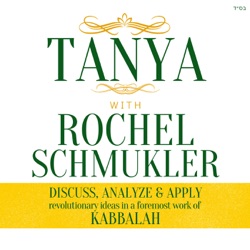Afleveringen
-
Zijn er afleveringen die ontbreken?
-
What if someone unwittingly ate forbidden food with the intention of serving Hashem—and even used the energy derived from that food to fuel their Torah study and prayer? Can this energy rise to holiness and become clothed within the words of Torah and prayer?
The vitality within forbidden foods is intrinsically tied to the three completely impure kelipot, meaning it cannot be elevated to holiness, no matter how pure one’s intentions. This reflects the Torah’s definition of assur—“tied up”—an objective reality that renders these foods inherently bound to impurity.
Permissible foods, by contrast, draw their vitality from kelipat nogah and can be elevated to holiness when approached with proper intent. However, indulging in them solely for self-gratification temporarily drags them into impurity, leaving a lasting imprint even after a person realigns themselves with holiness. This residual impurity requires chibut hakever, the “beating of the grave,” to divest the body of its attachment to worldly pleasures. -
Exploring kelipat nogah, the luminescent husk within the realm of impurity, which contains a mixture of good and holds the potential to be elevated to holiness or dragged into the depths of the three completely impure kelipot. Its destiny hinges on our intentions when interacting with the material world. When our focus is on serving Hashem, even the most luxurious items can be elevated to holiness, like a sacrifice on the altar. But when self-indulgence drives our actions, these objects are pulled deeper into spiritual obscurity, temporarily disappointing their potential.
-
How could anything exist if it opposes its essential life force? This is the secret of the exile of the Shechina—the Divine Presence—which vivifies forces that oppose it. Looking at this physical world and understanding the nature of kelipah—the obscuring husk—we can understand why darkness seems so prevalent here. And still, the infinite light of G-d fills this entire world through its investiture in the ten holy Sefirot.
-
Hashem created "one thing opposite the other." This means that all ten powers of the Divine soul have a corresponding counterpart in the animal soul, along with the three garments, or modes of expression. The emotional qualities of the animal soul are aligned with its intellectual nature.
How do we identify a thought, word, or action as an expression of the animal soul? And how do we recognize what belongs to "sitra achra -- the other side"? Anything not directed towards Hashem is automatically aligned with "the other side."
And how do we define holiness? Anything surrendered to the Divine is called holy—like the angels, who are in a constant, actualized state of surrender, or the Jewish person who would give up their life in martyrdom for the sake of Hashem. -
Understanding the Torah offers an incredible advantage above all other mitzvot: the Torah we study literally becomes part of our very being, which is why it is called "bread." Firstly, it integrates into us; secondly, it provides nourishment and life energy to our soul. In this way, Torah is like food for the soul, while mitzvot are the garments that clothe it. Our Sages teach that Torah is equivalent to all the mitzvot because it not only sustains the soul but also acts as a garment as we strive to understand it. And when we articulate the words of Torah out loud, it envelops us in an encompassing Divine light.
-
The Divine soul has three garments through which it finds expression: thought, speech, and deed, specifically through the 613 mitzvot of the Torah. The intellect of the Divine soul is expressed through the garment of thought, while its emotions—love and awe—manifest through the garments of speech and action. Speech and action become the expression of emotions because the true fulfillment of the mitzvot is driven by love. Fear, on the other hand, is expressed by observing the prohibitive Divine commands, which can stem from either an external fear of rebelling against Hashem's sovereignty or a deeper fear, where one feels ashamed to do anything or nurture anything that Hashem despises.
-
Returning to our experience with chochmah and binah: once awe and fear of Hashem are born, our hearts become ignited with a fiery passion for Him. Chochmah and binah are the father and mother that give rise to love and fear of Hashem. Indeed, all other emotions stem from this union, as every emotion is a derivative of these primary emotions of love and fear. Now, let’s consider the third "mother," the third intellectual faculty that gives rise to emotion: daat. Daat is not about acquiring new information; rather, it is the personalization of what we have perceived with chochmah and understood with binah. Through the daat experience, we deeply connect with this knowledge, allowing it to profoundly touch and transform us. It is only by focusing our minds on what we have perceived and comprehended about Hashem that we can cultivate lasting and vibrant emotions for Him.
-
Now let's look at the mechanism of the intellectual-emotional response. Every idea starts with a seminal point of inspiration, the point of chochmah. This point of inexplicable potential hovers just above our grasp, we don't own it and cannot explain it until we delve deeply into it, fleshing it out into its parts and particulars through the power of binah. When we apply this process to our intellectual appreciation of Hashem's astounding greatness, an awe of His transcendent majesty is born in our mind and moves to our heart as a real, palpable emotion.
- Laat meer zien


